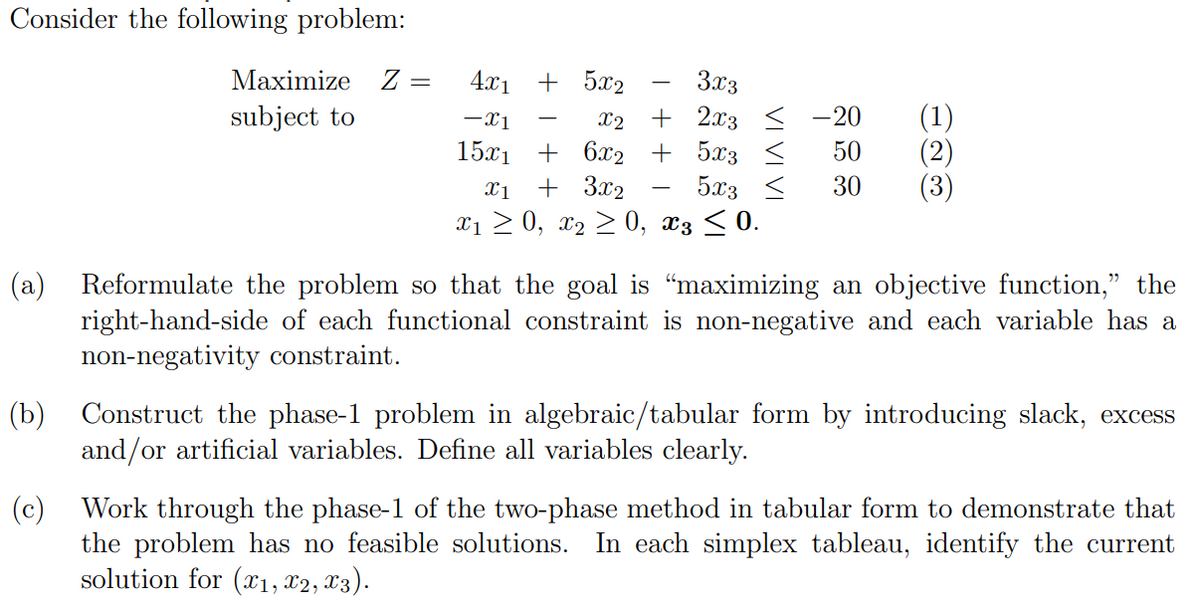asider the following problem: Maximize Z = 4.x1 + 5x2 3.x3 (1) (2) subject to -xị X2 + 2х3 < -20 15x1 + 6x2 + 5x3 < + 3x2 xị 2 0, x2 > 0, æ3 < 0. 50 X1 5x3 < 30 Reformulate the problem so that the goal is "maximizing an objective function," the right-hand-side of each functional constraint is non-negative and each variable has a non-negativity constraint. Construct the phase-1 problem in algebraic/tabular form by introducing slack, excess and/or artificial variables. Define all variables clearly. Work through the phase-1 of the two-phase method in tabular form to demonstrate that the problem has no feasible solutions. In each simplex tableau, identify the current solution for (x1, x2, x3).
asider the following problem: Maximize Z = 4.x1 + 5x2 3.x3 (1) (2) subject to -xị X2 + 2х3 < -20 15x1 + 6x2 + 5x3 < + 3x2 xị 2 0, x2 > 0, æ3 < 0. 50 X1 5x3 < 30 Reformulate the problem so that the goal is "maximizing an objective function," the right-hand-side of each functional constraint is non-negative and each variable has a non-negativity constraint. Construct the phase-1 problem in algebraic/tabular form by introducing slack, excess and/or artificial variables. Define all variables clearly. Work through the phase-1 of the two-phase method in tabular form to demonstrate that the problem has no feasible solutions. In each simplex tableau, identify the current solution for (x1, x2, x3).
Algebra for College Students
10th Edition
ISBN:9781285195780
Author:Jerome E. Kaufmann, Karen L. Schwitters
Publisher:Jerome E. Kaufmann, Karen L. Schwitters
Chapter12: Algebra Of Matrices
Section12.CR: Review Problem Set
Problem 35CR: Maximize the function fx,y=7x+5y in the region determined by the constraints of Problem 34.
Related questions
Question
Please provide detailed explanation.

Transcribed Image Text:Consider the following problem:
Maximize Z
subject to
4.x1 + 5x2
3x3
+ 2x3
15х1 + 622 + 523
5x3 <
(1)
(2)
(3)
-x1
X2
-20
50
X1
+ 3x2
30
Xı > 0, x2 > 0, æ3 < 0.
(a) Reformulate the problem so that the goal is "maximizing an objective function," the
right-hand-side of each functional constraint is non-negative and each variable has a
non-negativity constraint.
(b) Construct the phase-1 problem in algebraic/tabular form by introducing slack, excess
and/or artificial variables. Define all variables clearly.
(c) Work through the phase-1 of the two-phase method in tabular form to demonstrate that
the problem has no feasible solutions. In each simplex tableau, identify the current
solution for (x1, x2, X3).
VI VI VI
Expert Solution
This question has been solved!
Explore an expertly crafted, step-by-step solution for a thorough understanding of key concepts.
Step by step
Solved in 3 steps with 3 images

Recommended textbooks for you

Algebra for College Students
Algebra
ISBN:
9781285195780
Author:
Jerome E. Kaufmann, Karen L. Schwitters
Publisher:
Cengage Learning

Algebra: Structure And Method, Book 1
Algebra
ISBN:
9780395977224
Author:
Richard G. Brown, Mary P. Dolciani, Robert H. Sorgenfrey, William L. Cole
Publisher:
McDougal Littell

Algebra for College Students
Algebra
ISBN:
9781285195780
Author:
Jerome E. Kaufmann, Karen L. Schwitters
Publisher:
Cengage Learning

Algebra: Structure And Method, Book 1
Algebra
ISBN:
9780395977224
Author:
Richard G. Brown, Mary P. Dolciani, Robert H. Sorgenfrey, William L. Cole
Publisher:
McDougal Littell